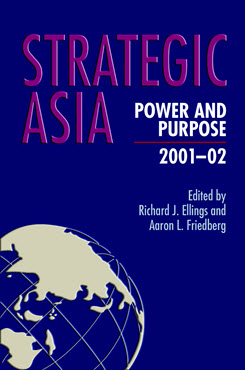Southeast Asia (Strategic Asia 2001-02)
Southeast Asia’s security problems tend to be more domestic than international, and given ASEAN’s reticence about involvement in the internal affairs of members, unsusceptible to regional mediation.
Despite the Cold War’s demise over a decade ago, its legacy lives on in Northeast Asia where the United States’ two major military commitments are located: 1) deterrence of North Korea and, if required, defense of South Korea; and 2) assisting Taiwan to maintain a military balance across the Taiwan Strait until a peaceful resolution of the political impasse between Taipei and Beijing can be reached. The U.S. security treaty with Japan has evolved essentially into the geostrategic base for this legacy, from which U.S. forces could deploy in the event of hostilities in either Korea or Taiwan, assuming Japan’s political concurrence.
By contrast, Southeast Asia has no such Cold War legacy. States aligned in the past or dependent on the former Soviet Union or China (Vietnam, Laos, Cambodia) are now full members of the Association of Southeast Asian Nations (ASEAN), an international organization originally founded in large part to protect noncommunist Southeast Asia from Chinese, Russian, and Indochinese communism. Again, unlike Northeast Asia, there are no American bases in Southeast Asia, the U.S. Navy and Air Force having vacated the Philippines in 1992. (Nevertheless, the U.S. armed forces do have bunkering and resupply arrangements—”places not bases”—in Singapore, Thailand, Indonesia, Malaysia, Brunei, and most recently the Philippines again.) U.S. air and naval forces move through Southeast Asia while patrolling the vast reaches of the Persian Gulf, Indian Ocean, South and East China Seas, as well as the western Pacific. In Southeast Asia, U.S. strategy focuses on maintaining the sea lines of communication (SLOCs) for the free flow of international commerce and access to allies in Northeast Asia should crises occur. This is not to say that Southeast Asia possesses no intrinsic importance. With a population of almost 500 million, a substantial natural resource base, and several of the world’s fastest growing economies over the past quartercentury,
Southeast Asia is an important trade and investment partner for the United States in a wide range of products from textiles to computer chips. Until the 1997–98 Asian financial crisis, the region was second only to Japan as a destination for U.S. exports. Its ten countries have a variety of political and economic systems and display wide disparities in development and political pluralism. Both ethnic and religious tensions characterize mainland and insular Southeast Asia, currently leading to low-level hostilities for Indonesia, Vietnam, the Philippines, and Burma. Neighboring states fear the prospect of spillover onto their territories, a situation that has already occurred in Thailand and Malaysia. Thus, Southeast Asia’s security problems tend to be more domestic than international, and given ASEAN’s reticence about involvement in the internal affairs of members, unsusceptible to regional mediation.
Strategic Asia
The Strategic Asia annual edited volume incorporates assessments of economic, political, and military trends and focuses on the strategies that drive policy in the region. Learn more about Strategic Asia.


